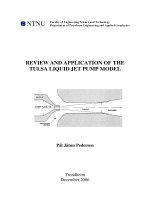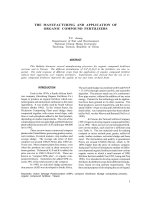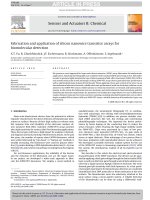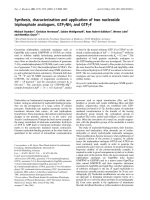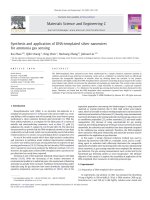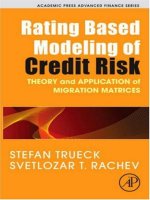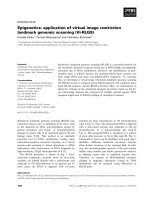grahn, geladi - techniques and application of hyperspectral image analysis
Bạn đang xem bản rút gọn của tài liệu. Xem và tải ngay bản đầy đủ của tài liệu tại đây (31.43 MB, 399 trang )
Techniques and Applications of
Hyperspectral Image Analysis
TechniquesandApplicationsofHyperspectralImageAnalysis Edited by H. F. Grahn and P. Geladi
©2007JohnWiley&Sons,Ltd. ISBN: 978-0-470-01086-0
Techniques and
Applications of
Hyperspectral Image
Analysis
Hans F. Grahn and Paul Geladi
Copyright © 2007 John Wiley & Sons Ltd, The Atrium, Southern Gate, Chichester,
West Sussex PO19 8SQ, England
Telephone (+44) 1243 779777
Email (for orders and customer service enquiries):
Visit our Home Page on www.wiley.com
All Rights Reserved. No part of this publication may be reproduced, stored in a retrieval system or
transmitted in any form or by any means, electronic, mechanical, photocopying, recording, scanning or
otherwise, except under the terms of the Copyright, Designs and Patents Act 1988 or under the terms of a
licence issued by the Copyright Licensing Agency Ltd, 90 Tottenham Court Road, London W1T 4LP, UK,
without the permission in writing of the Publisher. Requests to the Publisher should be addressed to the
Permissions Department, John Wiley & Sons Ltd, The Atrium, Southern Gate, Chichester, West Sussex
PO19 8SQ, England, or emailed to , or faxed to (+44) 1243 770620.
Designations used by companies to distinguish their products are often claimed as trademarks. All brand
names and product names used in this book are trade names, service marks, trademarks or registered
trademarks of their respective owners. The Publisher is not associated with any product or vendor
mentioned in this book.
This publication is designed to provide accurate and authoritative information in regard to the subject
matter covered. It is sold on the understanding that the Publisher is not engaged in rendering professional
services. If professional advice or other expert assistance is required, the services of a competent
professional should be sought.
The Publisher and the Author make no representations or warranties with respect to the accuracy or
completeness of the contents of this work and specifically disclaim all warranties, including without
limitation any implied warranties of fitness for a particular purpose. The advice and strategies contained
herein may not be suitable for every situation. In view of ongoing research, equipment modifications,
changes in governmental regulations, and the constant flow of information relating to the use of
experimental reagents, equipment, and devices, the reader is urged to review and evaluate the information
provided in the package insert or instructions for each chemical, piece of equipment, reagent, or device
for, among other things, any changes in the instructions or indication of usage and for added warnings
and precautions. The fact that an organization or Website is referred to in this work as a citation and/or a
potential source of further information does not mean that the author or the publisher endorses the
information the organization or Website may provide or recommendations it may make. Further, readers
should be aware that Internet Websites listed in this work may have changed or disappeared between
when this work was written and when it is read. No warranty may be created or extended by any
promotional statements for this work. Neither the Publisher nor the Author shall be liable for any
damages arising herefrom.
Other Wiley Editorial Offices
John Wiley & Sons Inc., 111 River Street, Hoboken, NJ 07030, USA
Jossey-Bass, 989 Market Street, San Francisco, CA 94103-1741, USA
Wiley-VCH Verlag GmbH, Boschstr. 12, D-69469 Weinheim, Germany
John Wiley & Sons Australia Ltd, 42 McDougall Street, Milton, Queensland 4064, Australia
John Wiley & Sons (Asia) Pte Ltd, 2 Clementi Loop #02-01, Jin Xing Distripark, Singapore 129809
John Wiley & Sons Canada Ltd, 6045 Freemont Blvd, Mississauga, Ontario, L5R 4J3, Canada
Wiley also publishes its books in a variety of electronic formats. Some content that appears in print may
not be available in electronic books.
Anniversary Logo Design: Richard J. Pacifico
Library of Congress Cataloging in Publication Data
Techniques and applications of hyperspectral image analysis / [edited by] Hans Grahn and Paul Geladi.
p. cm.
Includes bibliographical references.
ISBN 978-0-470-01086-0 (cloth)
1. Image processing—Statistical methods. 2. Multivariate analysis. 3. Multispectral photography.
I. Grahn, Hans. II. Geladi, Paul.
TA1637.T42 2007
621.36
7—dc22 2007021097
British Library Cataloguing in Publication Data
A catalogue record for this book is available from the British Library
ISBN 978-0-470-01086-0
Typeset in 10/12pt Times by Integra Software Services Pvt. Ltd, Pondicherry, India
Printed and bound in Great Britain by TJ International, Padstow, Cornwall
This book is printed on acid-free paper responsibly manufactured from sustainable forestry in which
at least two trees are planted for each one used for paper production.
Contents
Preface xiii
List of Contributors xvii
List of Abbreviations xix
1 Multivariate Images, Hyperspectral Imaging: Background and
Equipment 1
Paul L. M. Geladi, Hans F. Grahn and James E. Burger
1.1 Introduction 1
1.2 Digital Images, Multivariate Images and Hyperspectral
Images 1
1.3 Hyperspectral Image Generation 5
1.3.1 Introduction 5
1.3.2 Point Scanning Imaging 6
1.3.3 Line Scanning Imaging 7
1.3.4 Focal Plane Scanning Imaging 8
1.4 Essentials of Image Analysis Connecting Scene and
Variable Spaces 9
References 14
2 Principles of Multivariate Image Analysis (MIA) in Remote
Sensing, Technology and Industry 17
Kim H. Esbensen and Thorbjørn T. Lied
2.1 Introduction 17
2.1.1 MIA Approach: Synopsis 18
2.2 Dataset Presentation 18
2.2.1 Master Dataset: Rationale 18
2.2.2 Montmorency Forest, Quebec, Canada: Forestry
Background 19
vi CONTENTS
2.3 Tools in MIA 21
2.3.1 MIA Score Space Starting Point 21
2.3.2 Colour-slice Contouring in Score Cross-plots:
a 3-D Histogram 24
2.3.3 Brushing: Relating Different Score Cross-plots 24
2.3.4 Joint Normal Distribution (or Not) 26
2.3.5 Local Models/Local Modelling: a Link to
Classification 27
2.4 MIA Analysis Concept: Master Dataset Illustrations 28
2.4.1 A New Topographic Map Analogy 28
2.4.2 MIA Topographic Score Space Delineation of
Single Classes 31
2.4.3 MIA Delineation of End-member Mixing
Classes 33
2.4.4 Which to Use? When? How? 38
2.4.5 Scene-space Sampling in Score Space 39
2.5 Conclusions 40
References 41
3 Clustering and Classification in Multispectral Imaging for
Quality Inspection of Postharvest Products 43
Jacco C. Noordam and Willie H. A. M. van den Broek
3.1 Introduction to Multispectral Imaging in Agriculture 43
3.1.1 Measuring Quality 43
3.1.2 Spectral Imaging in Agriculture 44
3.2 Unsupervised Classification of Multispectral Images 46
3.2.1 Unsupervised Classification with FCM 46
3.2.2 FCM Clustering 47
3.2.3 cFCM Clustering 48
3.2.4 csiFCM 49
3.2.5 Combining Spectral and Spatial Information 51
3.2.6 sgFCM Clustering 52
3.3 Supervised Classification of Multispectral Images 54
3.3.1 Multivariate Image Analysis for Training Set
Selection 55
3.3.2 FEMOS 57
3.3.3 Experiment with a Multispectral Image of Pine
and Spruce Wood 58
3.3.4 Clustering with FEMOS Procedure 60
CONTENTS vii
3.4 Visualization and Coloring of Segmented Images and
Graphs: Class Coloring 62
3.5 Conclusions 64
References 65
4 Self-modeling Image Analysis with SIMPLISMA 69
Willem Windig, Sharon Markel and Patrick M. Thompson
4.1 Introduction 69
4.2 Materials and Methods 70
4.2.1 FTIR Microscopy 70
4.2.2 SIMS Imaging of a Mixture of Palmitic and Stearic
Acids on Aluminum foil 71
4.2.3 Data Analysis 73
4.3 Theory 73
4.4 Results and Discussion 75
4.4.1 FTIR Microscopy Transmission Data of a
Polymer Laminate 75
4.4.2 FTIR Reflectance Data of a Mixture of Aspirin
and Sugar 80
4.4.3 SIMS Imaging of a Mixture of Palmitic and
Stearic Acids on Aluminum Foil 80
4.5 Conclusions 85
References 87
5 Multivariate Analysis of Spectral Images Composed of
Count Data 89
Michael R. Keenan
5.1 Introduction 89
5.2 Example Datasets and Simulations 92
5.3 Component Analysis 95
5.4 Orthogonal Matrix Factorization 96
5.4.1 PCA and Related Methods 97
5.4.2 PCA of Arbitrary Factor Models 102
5.4.3 Maximum Likelihood PCA (MLPCA) 104
5.4.4 Weighted PCA (WPCA) 105
5.4.5 Principal Factor Analysis (PFA) 107
5.4.6 Selecting the Number of Components 108
5.5 Maximum Likelihood Based Approaches 113
5.5.1 Poisson Non-negative Matrix Factorization
(PNNMF) 114
viii CONTENTS
5.5.2 Iteratively Weighted Least Squares (IWLS) 117
5.5.3 NNMF: Gaussian Case (Approximate Noise) 118
5.5.4 Factored NNMF: Gaussian Case
(Approximate Data) 119
5.5.5 Alternating Least Squares (ALS) 120
5.5.6 Performance Comparisons 121
5.6 Conclusions 124
Acknowledgements 125
References 125
6 Hyperspectral Image Data Conditioning and Regression
Analysis 127
James E. Burger and Paul L. M. Geladi
6.1 Introduction 127
6.2 Terminology 128
6.3 Multivariate Image Regression 128
6.3.1 Regression Diagnostics 130
6.3.2 Differences between Normal Calibration and
Image Calibration 132
6.4 Data Conditioning 132
6.4.1 Reflectance Transformation and Standardization 133
6.4.2 Spectral Transformations 135
6.4.3 Data Clean-up 137
6.4.4 Data Conditioning Summary 138
6.5 PLS Regression Optimization 138
6.5.1 Data Subset Selection 138
6.5.2 Pseudorank Determination 139
6.6 Regression Examples 140
6.6.1 Artificial Ternary Mixture 142
6.6.2 Commercial Cheese Samples 146
6.6.3 Wheat Straw Wax 149
6.7 Conclusions 150
Acknowledgements 152
References 152
7 Principles of Image Cross-validation (ICV): Representative
Segmentation of Image Data Structures 155
Kim H. Esbensen and Thorbjørn T. Lied
7.1 Introduction 155
7.2 Validation Issues 156
CONTENTS ix
7.2.1 2-way 156
7.2.2 MIA/MIR 158
7.3 Case Studies 160
7.3.1 Case 1: Full Y-image 163
7.3.2 Case 2: Critical Segmentation Issues 165
7.3.3 Case 3: Y-composite 168
7.3.4 Case 4: Image Data Structure Sampling 173
7.4 Discussion and Conclusions 177
7.5 Reflections on 2-way Cross-validation 178
References 180
8 Detection, Classification, and Quantification in
Hyperspectral Images Using Classical Least
Squares Models 181
Neal B. Gallagher
8.1 Introduction 181
8.2 CLS Models 182
8.2.1 CLS 183
8.2.2 ELS 187
8.2.3 GLS 189
8.3 Detection, Classification, and Quantification 192
8.3.1 Detection 194
8.3.2 Classification 196
8.3.3 Quantification 197
8.4 Conclusions 200
Acknowledgements 200
References 201
9 Calibration Standards and Image Calibration 203
Paul L. M. Geladi
9.1 Introduction 203
9.2 The Need for Calibration in General 203
9.3 The Need for Image Calibration 204
9.4 Resolution in Hyperspectral Images 205
9.5 Spectroscopic Definitions 207
9.6 Calibration Standards 209
9.7 Calibration in Hyperspectral Images 213
9.8 Conclusions 219
References 219
x CONTENTS
10 Multivariate Movies and their Applications in
Pharmaceutical and Polymer Dissolution Studies 221
Jaap van der Weerd and Sergei G. Kazarian
10.1 Introduction 221
10.1.1 Introducing the Time Axis 222
10.1.2 Data Structure and Reduction 223
10.1.3 Compression of Spectra 224
10.1.4 Space Dimensions 227
10.1.5 Time Dimension 231
10.1.6 Simultaneous Compression of all Variables 235
10.2 Applications: Solvent Diffusion and
Pharmaceutical Studies 237
10.2.1 Solvent Diffusion in Polymers 238
10.2.2 Optical and NMR Studies 242
10.2.3 Line Imaging 245
10.2.4 Global MIR Imaging Studies of Solvent
Intake 246
10.3 Drug Release 249
10.3.1 ATR-FTIR Imaging 251
10.4 Conclusions 254
Acknowledgement 255
References 255
11 Multivariate Image Analysis of Magnetic Resonance
Images: Component Resolution with the Direct
Exponential Curve Resolution Algorithm (DECRA) 261
Brian Antalek, Willem Windig and Joseph P. Hornak
11.1 Introduction 261
11.2 DECRA Approach 264
11.3 DECRA Algorithm 269
11.4
1
H Relaxation 270
11.5 T
1
Transformation 271
11.6 Imaging Methods 271
11.7 Phantom Images 273
11.7.1 T
2
Series 273
11.7.2 T
1
Series 277
11.8 Brain Images 278
11.8.1 T
2
Series 278
11.8.2 T
1
Series 281
11.9 Regression Analysis 282
11.10 Conclusions 285
References 285
CONTENTS xi
12 Hyperspectral Imaging Techniques: an Attractive Solution
for the Analysis of Biological and Agricultural Materials 289
Vincent Baeten, Juan Antonio Fernández Pierna and
Pierre Dardenne
12.1 Introduction 289
12.2 Sample Characterization and Chemical Species
Distribution 291
12.2.1 Analysis of Fruit 291
12.2.2 Analysis of Kernels 294
12.2.3 Analysis of Food and Feed Mixtures 296
12.3 Detecting Contamination and Defects in Agro-food
Products 297
12.3.1 Detecting Contamination in Meat
Products 297
12.3.2 Detecting Contamination and Defects in
Fruit 298
12.3.3 Detecting Contamination and Defects in
Cereals 301
12.3.4 Detecting Contamination in Compound
Feed 302
12.4 Other Agronomic and Biological Applications 304
12.5 Conclusion 306
References 307
13 Application of Multivariate Image Analysis in Nuclear
Medicine: Principal Component Analysis (PCA) on Dynamic
Human Brain Studies with Positron Emission Tomography
(PET) for Discrimination of Areas of Disease at High
Noise Levels 313
Pasha Razifar and Mats Bergström
13.1 Introduction 313
13.2 PET 315
13.2.1 History 315
13.2.2 Principles 315
13.2.3 Scanning Modes in PET 317
13.2.4 Analysis of PET Data/Images 318
13.3 PCA 319
13.3.1 History 319
13.3.2 Definition 319
13.3.3 Pre-processing and Scaling 320
13.3.4 Noise Pre-normalization 321
xii CONTENTS
13.4 Application of PCA in PET 322
13.4.1 SWPCA 323
13.4.2 VWPCA 326
13.4.3 MVWPCA 327
13.5 Conclusions 330
References 332
14 Near Infrared Chemical Imaging: Beyond the Pictures 335
E. Neil Lewis, Janie Dubois, Linda H. Kidder and
Kenneth S. Haber
14.1 Introduction 335
14.2 Data Measurement 338
14.3 Selection of Samples and Acquisition Schemes 340
14.4 What, How Much and Where 343
14.5 Data Analysis and the Underlying Structure
of the Data 344
14.6 Imaging with Statistically Meaningful
Spatial Dimensions 348
14.7 Chemical Contrast 350
14.8 Measure, Count and Compare 355
14.9 Correlating Data to Sample Performance and/or
Behavior: the Value of NIRCI Data 359
14.10 Conclusions 360
References 361
Index 363
Preface
This book is about multivariate and hyperspectral imaging, not only
on how to make the images but on how to clean, transform, analyze
and present them. The emphasis is on visualization of images, models
and statistical diagnostics, but some useful numbers and equations are
given where needed. The idea to write this book originated at an Image
Analysis Session at the Eastern Analytical Symposium (Somerset, NJ) in
November 2002. At this session, the lectures were so inspiring that it
was felt necessary to have something on paper for those not present.
An earlier book, also published by John Wiley & Sons, Ltd, came
out in 1996. It was called Multivariate Image Analysis by Geladi and
Grahn. This book contains a lot of the basic theory. The examples in
this book are not very advanced because in the early 1990s it was not
so easy to get 10 or more wavelength bands in an image. There has also
been an evolution in theory and algorithms, requiring additions to the
1996 book, but a major difference is that image files are much larger in
size and sizes are expected to keep on growing. This is a challenge to
the data analysis methods and algorithms, but it is also an opportunity
to get more detailed results with higher precision and accuracy.
It would have been possible to make a revised second edition of Geladi
and Grahn, but it was considered more useful to include extra authors,
thus creating a multi-authored book with chapters on hyperspectral
imaging. The chapters would be written by groups or persons whom
we felt would be able to contribute something meaningful. The book
can roughly be divided into two parts. The earlier chapters are about
definitions, nomenclature and data analytical and visualization aspects.
The later chapters present examples from different fields of science,
including extra data analytical aspects. The subdivision in theory and
application parts is not ideal. Many attempts of putting the chapters in
the correct order were tried and the final result is only one of them.
xiv PREFACE
Chapter 1 is about the definition of multivariate and hyperspectral
images and introduces nomenclature. It contains basic information that
is applicable to all subsequent chapters. The basic ideas of multivariate
interactive image analysis are explained with a simple color (three chan-
nels) photograph.
Chapters 2–5 give a good insight into factor and component modeling
used on the spectral information in the images. This is called multi-
variate image analysis (MIA). Chapter 2 introduces interactive explo-
ration of multivariate images in the scene and variable space in more
detail using an eight channel optical image taken from an airplane. The
role of visualization in this work is extremely important; something that
Chapter 2 succeeds in highlighting. Chapter 3 gives a good overview
of classification in optical images of agricultural products. The special
topics of fuzzy clustering and clustering aided by spatial information
are explained. In Chapter 4, the SIMPLISMA technique and its use on
images are explained. This technique is an important alternative to those
explained in Chapters 2 and 3. SIMPLISMA is not just exploratory, but
tries to find deterministic pure component spectra by using spectroscopic
constraints on the model. The examples are from Fourier transform
infrared (FTIR) and time-of-flight - secondary ion mass spectrometry
(TOF-SIMS) imaging. Chapter 5 is about even more factor analysis
methods that can be applied to hyperspectral images. The special case
of unsymmetrical noise distributions is emphasized.
Chapters 6–9 introduce the concepts and models for regression
modeling on hyperspectral images: multivariate image regression (MIR).
Chapter 6 is about regression on image data. This is the situation where
the spectrum in each pixel is able to predict the value of an external
variable, be it another image, an average property or something in
between like localized information. Emphasis is also given on cleaning
and preprocessing a hyperspectral image to make the spectral infor-
mation suitable for regression model building. Chapter 7 takes up the
important aspect of validation in classification and regression on images.
The example of Chapter 2 is reused by defining one of the channels as
a dependent variable. Also, a new example for the calibration of fat
content in sausages is introduced. The advantage of image data is that
many pixels (=spectra) are available, making testing on subsets a much
easier task. Chapter 8 describes classical, extended and general least
squares models for Raman images of aspirin/polyethylene mixtures. The
theory part is extensive. Chapter 9 is about the need for expressing
hyperspectral data in the proper SI and IUPAC units and about stan-
dards for multivariate and hyperspectral imaging. In particular, diffuse
PREFACE xv
reflection, the most practical technique of imaging used in the labora-
tory, is in need of such standardization. Without the standards, repro-
ducible image data would not be available and spectral model building
and interpretation would be hampered severely.
The applied chapters do not give a complete overview of all possible
applications, but they give a reasonable catalog of things that can
be done with hyperspectral images using different types of variables.
Chapter 10 is about multivariate movies in different variables, mainly
optical, infrared, Raman and nuclear magnetic resonance (NMR).
Multivariate movies represent huge amounts of data and efficient data
reduction is needed. The applications are in polymer and pharmaceutical
tablet dissolution. Chapter 11 describes the DECRA technique as it can
be used on phantoms and brain images in magnetic resonance imaging.
Chapter 12 gives an overview of agricultural and biological applica-
tions of optical multivariate and hyperspectral imaging. Chapter 13 is
about brain studies using positron emission tomography (PET). The
PET images are extremely noisy and require special care. Chapter 14 is
about chemical imaging using near infrared spectroscopy. Pharmaceu-
tical granulate mixtures are the examples used.
When writing a book one should always have students in mind. Books
are ideal as course material and there is not much material available yet
for learning about nonremote sensing hyperspectral imaging. Recom-
mendations for newcomers are to read Chapters 1–9 together with
Geladi and Grahn (Geladi and Grahn, 1996) in order to get the basics.
Chapters 2–5 form the factor analysis block and Chapters 6–9 form
the regression/calibration block. More advanced readers may review the
basics quickly and plunge directly into the applied chapters (10–15).
An alternative choice of reading would be Bhargava and Levin (Bhar-
gava and Levin, 2005). There are also some interesting books from the
remote sensing field (Chang, 2003; Varhsney and Arora, 2004).
REFERENCES
Bhargava, R. and Levin, I. (Eds) (2005) Spectrochemical Analysis Using Infrared
Multichannel Detectors, Blackwell, Oxford.
Chang, C. (2003) Hyperspectral Imaging: Techniques for Spectral Detection and Classi-
fication, Kluwer Academic Publishers, Dordrecht.
Geladi, P. and Grahn, H. (1996) Multivariate Image Analysis, John Wiley & Sons, Ltd,
Chichester.
Varshney, K. and Arora, M. (Eds) (2004) Advanced Image Processing Techniques for
Remotely Sensed Hyperspectral Data, Springer, Berlin.
List of Contributors
Brian Antalek, Eastman Kodak Company, Research Laboratories B82,
Rochester, NY 14650-2132, USA
Vincent Baeten, Département Qualité des Produits agricoles, Centre
wallon de recherches agronomiques CRA-W, 24, Chaussée de Namur,
B-5030 Gembloux, Belgium
Mats Bergström, Novartis Pharma AG, CH-4002, Basel, Switzerland
James E. Burger, Burger Metrics, Applied Hyperspectral Imaging for
Automation and Research, Ladehammerveien 36, 7041 Trondheim,
Norway
Pierre Dardenne, Département Qualité des Produits agricoles, Centre
wallon de recherches agronomiques CRA-W, 24, Chaussée de Namur,
B-5030 Gembloux, Belgium
Jane Dubois, Malvern Instruments, Analytical Imaging Systems, 3416
Olandwood Court #210, Olney, MD 20832, USA
Kim H. Esbensen, ACABS, Aalborg University Esbjerg (AAUE), Niels
Bohrs Vej 8, DK-6700 Esbjerg, Denmark
Neal B. Gallagher, Eigenvector Research, Inc., 160 Gobblers Knob Lane,
Manson, WA 98831, USA
Paul L. M. Geladi, NIRCE, The Unit of Biomass Technology and Chem-
istry SLU Röbäcksdalen, PO Box 4097, SE 90403 Umeå, Sweden
Hans F. Grahn, Division of Behavioral Neuroscience, Department of
Neuroscience, Karolinska Institutet, S-17177, Stockholm, Sweden
xviii LIST OF CONTRIBUTORS
Kenneth S. Haber, Malvern Instruments, Analytical Imaging Systems,
3416 Olandwood Court #210, Olney, MD 20832, USA
Joseph P. Hornak, Magnetic Resonance Laboratory, 54 Lomb Memorial
Drive, Center for Imaging Science, Rochester Institute of Technology,
Rochester, NY 14623-5604, USA
Sergei G. Kazarian, Department of Chemical Engineering, ACE Building
208A/210, Imperial College London, South Kensington Campus,
London SW7 2AZ, UK
Michael R. Keenan, Sandia National Laboratories, Albuquerque, NM
87185-0886, USA
Linda H. Kidder, Malvern Instruments, Analytical Imaging Systems,
3416 Olandwood Court #210, Olney, MD 20832, USA
E. Neil Lewis, Malvern Instruments, Analytical Imaging Systems, 3416
Olandwood Court #210, Olney, MD 20832, USA
Sharon Markel, Eastman Kodak Company, Rochester, NY 14650-2132,
USA
Jacco C. Noordam, TNO Defence, Security and Safety, PO Box 96864,
2509 JG The Hague, The Netherlands
Juan Antonio Fernández Pierna, Département Qualité des Produits agri-
coles, Centre wallon de recherches agronomiques CRA-W, 24, Chaussée
de Namur, B-5030 Gembloux, Belgium
Pasha Razifar, Computerized Image Analysis & PET Uppsala Applied
Science Lab (UASL) GEMS PET Systems AB, Husbyborg, 752 28
Uppsala, Sweden
P. M. Thompson, Eastman Kodak Company, Rochester, NY 14650-
2132, USA
Thorbjørn Tønnesen Lied, Kongsberg Maritime AS, R&D, Hydrog-
raphy & Hydroacustic Division, Horten, Norway
Willie H. A. M. van den Broek, TNO Defence, Security and Safety, PO
Box 96864, 2509 JG The Hague, The Netherlands
Jaap van der Weerd, Department of Chemical Engineering, Imperial
College London, South Kensington Campus, London SW7 2AZ, UK
Willem Windig, Eigenvector Research, Inc., 6 Olympia Drive, Rochester,
NY 14615, USA
List of Abbreviations
2-D Two-dimensional
3-D Three-dimensional
ABES Agricultural, biology and environmental sciences
ACD Annihilation coincidence detection
AIS Airborne imaging system
ALS Alternating least squares
ANN Artificial neural network
ARMA Autoregressive moving average
AOTF Acousto-optic tunable filter
API Active pharmaceutical ingredient
ATR Attenuated total reflection
AVHRR Advanced very high resolution radiometer
AVIRIS Airborne visible and infrared imaging spectrometer
CAS Chemical Abstracts Service
CASI Compact airborne spectrographic imager
CCD Charge coupled device
CLS Classical least squares
cFCM Conditional Fuzzy C-Means
CSF Cerebrospinal fluid
csiFCM Cluster size insensitive Fuzzy C-Means
DECRA Direct exponential curve resolution analysis
EDS Energy dispersive spectrometer (mainly X-rays)
EMSC Extended multiplicative scatter correction
ELS Extended least squares
FA Factor analysis
fALS Factored alternating least squares
FCM Fuzzy C-Means
FEMOS Feedback Multivariate Model Selection
xx LIST OF ABBREVIATIONS
fNNMF Factored non-negative matrix factorization
FBP Filtered back projection
FOV Field of view
FPA Focal plane array
FT Fourier transform
FTIR Fourier transform infrared
FWHM Full width at half maximum
GIS Geographical information system
GLS Generalized least squares
GOME Global ozone monitoring experiment
GPS Global positioning system
GRAM Generalized rank annihilation method
HD High density (for polymers)
HIA Hyperspectral image analysis
HPLC High pressure liquid chromatography
HPMC Hydroxypropylmethylcellulose
ICV Image cross-validation
ILS Inverse least squares
ILS Iterative partial least squares
IR Infrared
IUPAC International Union of Pure and Applied Chemistry
IWLS Iteratively weighted least squares
LCTF Liquid crystal tunable filter
LD Low density (for polymers)
LDA Linear discriminant analysis
LOR Line of response
LUT Look up table
MBM Meat and bone meal
MCR Multivariate curve resolution
MEIS Multispectral electro-optical imaging spectrometer
MI Multivariate image
MIA Multivariate image analysis
MIR Multivariate image regression
MIR Mid infrared
MLPCA Maximum likelihood principal component analysis
MNF Minimum noise fraction
MRI Magnetic resonance imaging
MSC Multiplicative scatter correction
MVWPCA Masked volume wise principal component analysis
NIR Near infrared
NIRCI Near infrared chemical imaging
LIST OF ABBREVIATIONS xxi
NMR Nuclear magnetic resonance
NNMF Non-negative matrix factorization
NSLS National Synchrotron Light Source
OSEM Ordered subset expectation maximization
PAL Phase alternating line
PAA Polyacrylamide
PAMS Poly (-methyl styrene)
PAS Photo-acoustic spectroscopy
PBMA Poly (butyl methacrylate)
PC Principal component
PCA Principal component analysis
PCR Principal component regression
PE Polyethylene
PET Poly (ethylene terephthalate)
PET Positron emission tomography
PETT Positron emisison transaxial tomography
PFA Principal factor analysis
PGP Prism–grating–prism
PGSE Pulse gradient spin echo
PLS Partial least squares
PMSC Piecewise multiplicative scatter correction
PNNMF Poisson non-negative matrix factorization
PVA Poly (vinyl alcohol)
PVC Poly (vinyl chloride)
PW Pixel wise
PRESS Prediction residual error sum of squares
QA Quality assurance
QC Quality control
RGB Red green blue
RMSEC Root mean square error of calibration
RMSECV Root mean square error of cross-validation
RMSEP Root mean square error of prediction
ROI Region of interest
SECAM Séquentielle couleur a mémoire
SECV Standard error of cross-validation
SEM Scanning electron microscope
SIA Self-modeling image analysis
sgFCM Spatially guided Fuzzy C-Means
SI Système international
SLDA Stepwise linear discriminant analysis
SIMCA Soft independent modeling of class analogy
xxii LIST OF ABBREVIATIONS
SIMPLISMA Simple-to-use interactive self-modeling mixture
analysis
SIMS Secondary ion mass spectrometry
SNR Signal to noise ratio
SNV Standard normal variate
SPOT Satellite pour l’observation du terre
SRM Standard reference material
SS Sum of squares
SSE Sum of squared errors
SVD Singular value decomposition
SVM Support Vector Machine
SWPCA Slice wise principal component analysis
TAC Time–activity curve
TOF-SIMS Time-of-flight-secondary ion mass spectrometry
TOMS Total ozone mapping spectrometer
USP United States Pharmacopeia
UV Ultraviolet
VWPCA Volume wise principal component analysis
WPCA Weighted principal component analysis
WTFA Window target factor analysis
1
Multivariate Images,
Hyperspectral Imaging:
Background and Equipment
Paul L. M. Geladi, Hans F. Grahn and James E. Burger
1.1 INTRODUCTION
This chapter introduces the concepts of digital image, multivariate
image and hyperspectral image and gives an overview of some of the
image generation techniques for producing multivariate and hyperspec-
tral images. The emphasis is on imaging in the laboratory or hospital
on a scale going from macroscopic to microscopic. Images describing
very large scenes are not mentioned. Therefore, the specialized research
fields of satellite and airborne imaging and also astronomy are left out.
A color image is used to introduce the multivariate interactive visual-
ization principles that will play a major role in further chapters.
1.2 DIGITAL IMAGES, MULTIVARIATE IMAGES
AND HYPERSPECTRAL IMAGES
All scientific activity aims at gathering information and turning this
information into conclusions, decisions or new questions. The informa-
tion may be qualitative, but is often and preferably quantitative. This
TechniquesandApplicationsofHyperspectralImageAnalysis Edited by H. F. Grahn and P. Geladi
©2007JohnWiley&Sons,Ltd. ISBN: 978-0-470-01086-0
2 MULTIVARIATE IMAGES, HYPERSPECTRAL IMAGING
means that the information is a number or a set of numbers. Sometimes
even a large set of numbers is not enough and an image is needed.
Images have the dual property of both being large datasets and visually
interpretable entities.
Freehand drawing and photography have been used extensively in the
sciences to convey information that would be too complicated to be
expressed in a text or in a few numbers. From the middle of the 1900s
the TV camera and electronic image digitization have become available
and images can be saved in digital format as files (Geladi and Grahn,
2000). A digital image is an array of I rows and J columns made of I × J
greyvalues or intensities, also called pixels. A pixel is a greyvalue with
an associated coordinate in the image. The image is also a data matrix
of size I × J with the greyvalues as entries. (Pratt, 1978; Rosenfeld and
Kak, 1982; Gonzalez and Woods, 1992; Schotton, 1993) For three-
dimensional images, the array has I rows, J columns and H depth slices.
The pixel becomes a voxel. For color imaging in TV, video and on
computer screens, three images are needed to contain the red, green
and blue information needed to give the illusion of color to the human
eye (Callet, 1998; Johnson and Fairchild, 2004) For photocopying and
printing the three primary colors are yellow, cyan and magenta. One
may say that the pixels (or voxels) are not greyvalues anymore, but
triplets of numbers (Figure 1.1).
J columns
I rows
Figure 1.1 A digital image is an array of I rows and J columns. Each coordinate
pair has a greyvalue and the small grey square (or rectangle) is called a pixel. For
color images, the pixel becomes a red, green and blue triplet instead of a greyvalue
DIGITAL, MULTIVARIATE AND HYPERSPECTRAL IMAGES 3
Because pixels are digitized greyvalues or intensities, they may be
expressed as integers. Simple images may have a greyvalue range of 2
8
meaning that 0 is the blackest black and 255 is the whitest white. In
more advanced systems, 2
12
grey levels (0–4095), 2
14
or 2
16
greylevels
are used. Some systems average images over a number of scans. In such
a case, greylevels may have decimals and have to be expressed as double
precision numbers.
The fact that a digitized image is a data matrix makes it easy to do
calculations on it. The result of the calculations can be a number, a
vector of numbers or a modified image. Some simple examples would
be counting of particles (image to number), the calculation of intensity
histograms (image to vector), image smoothing and edge enhancement
(image to modified image). There are many books describing how this
is done (Pratt, 1978; Rosenfeld and Kak, 1982; Low, 1991; Gonzalez
and Woods, 1992).
Color imageshave three layers (or bands) that each have differentinfor-
mation. It is possible to make even more layers by using smaller wave-
length bands, say 20 nm wide between 400 nm and 800 nm. Then each
pixel would be a spectrum of 21wavelength bands. This is the multivariate
image. The 21 wavelength bands in the example are called the image vari-
ables and in general there are K variables. An I × J image in K variables
would form a three-way array of size I × J × K. (Figures 1.2–1.4).
K variables
J columns
I rows
Figure 1.2 An I × J image in K variables is an I × J × K array of data
4 MULTIVARIATE IMAGES, HYPERSPECTRAL IMAGING
K variables
J columns
I rows
Figure 1.3 The I × J × K image can be presented as K slices where each slice is a
greyvalue image
K variables
J columns
I rows
Figure 1.4 The I × J × K image can be presented as an image of vectors. In special
cases. the vectors can be shown and interpreted as spectra
The human eye only needs the three wavelength bands red, green and
blue in order to see color. With more than three wavelength bands,
simple color representation is not possible, but some artificial color
images may be made by combining any three bands. In that case the
colors are not real and are called pseudocolors. This technique makes

